NIT2271 ICT Change Management: Sunoco, Inc. Detailed Plan
VerifiedAdded on 2023/04/03
|9
|2057
|125
Report
AI Summary
This change management plan outlines the process for Sunoco, Inc. to migrate its operational data to a cloud-based system. The plan details the reasons for change, the type and scope of the change, and the roles and responsibilities of the change management team. It includes a change analysis covering process, people, stakeholder analysis, resistance analysis, risk and impact analysis, and organizational change readiness. The change implementation plan covers action, communication, business system, and training plans, as well as change evaluation criteria. Post-implementation activities and a peer review are also included, emphasizing team collaboration and individual contributions to the project, with references to support the plan's strategies and recommendations. The primary objective is to ensure a secure and effective transition to cloud-based data warehousing and business intelligence, improving data management and decision-making within the organization.
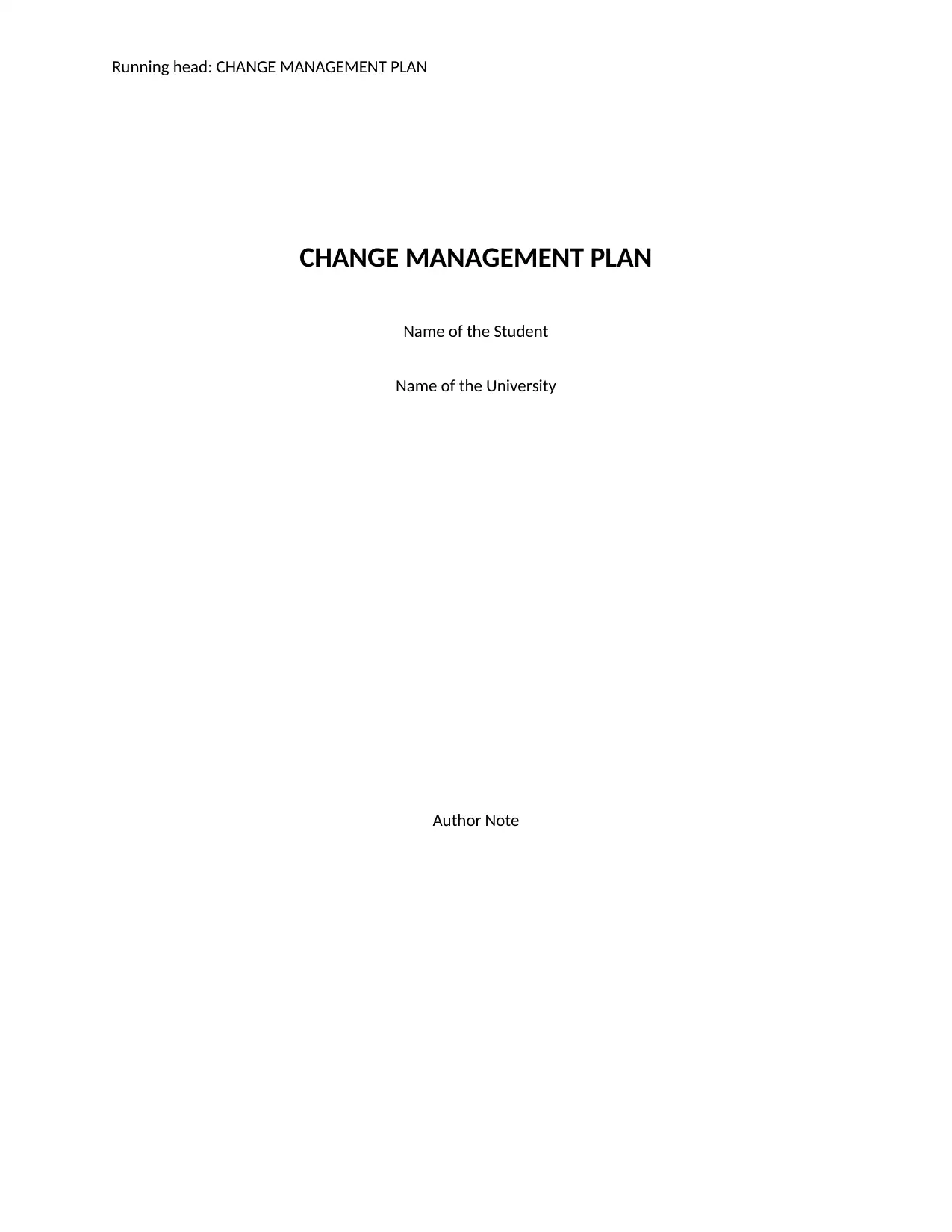
Running head: CHANGE MANAGEMENT PLAN
CHANGE MANAGEMENT PLAN
Name of the Student
Name of the University
Author Note
CHANGE MANAGEMENT PLAN
Name of the Student
Name of the University
Author Note
Paraphrase This Document
Need a fresh take? Get an instant paraphrase of this document with our AI Paraphraser
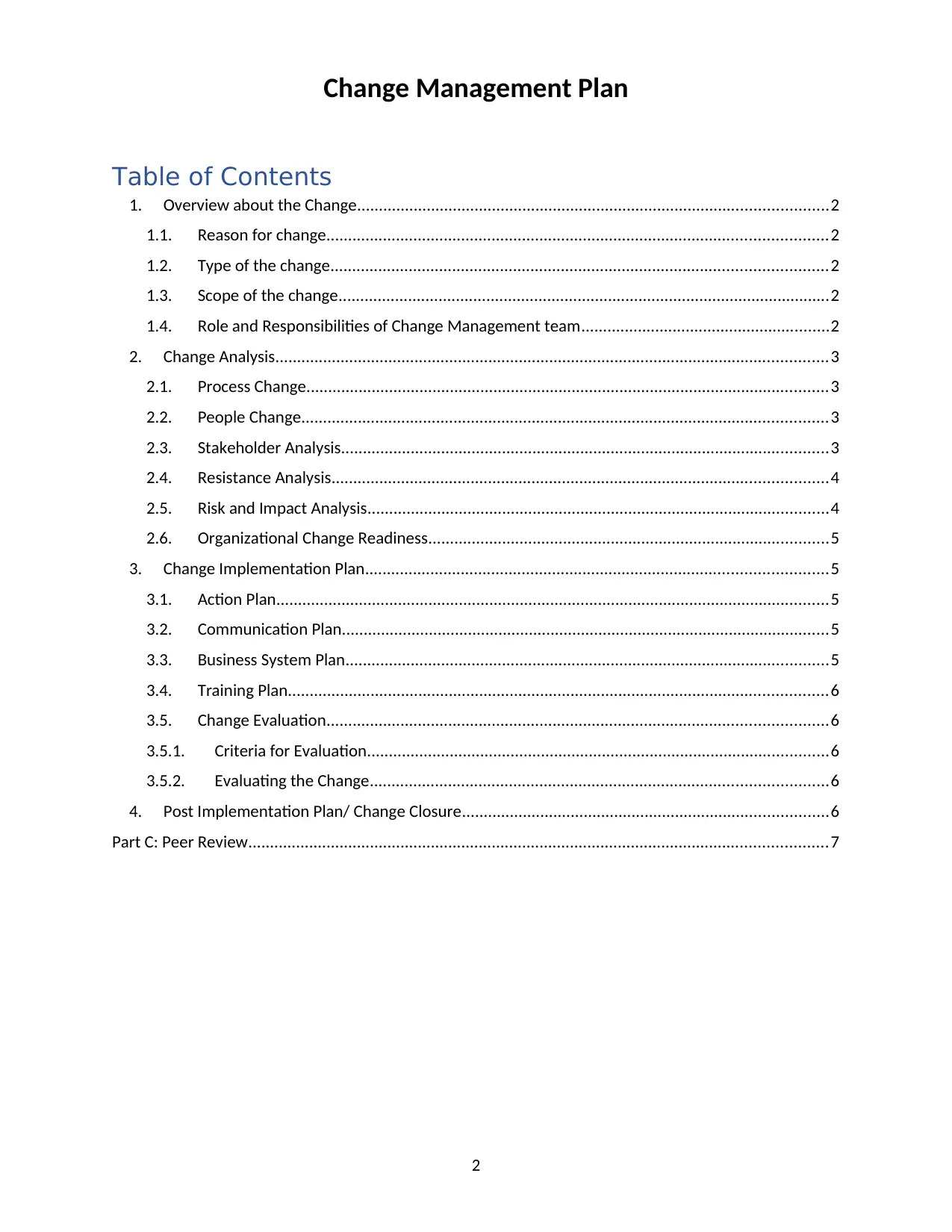
Change Management Plan
Table of Contents
1. Overview about the Change............................................................................................................2
1.1. Reason for change...................................................................................................................2
1.2. Type of the change..................................................................................................................2
1.3. Scope of the change.................................................................................................................2
1.4. Role and Responsibilities of Change Management team.........................................................2
2. Change Analysis...............................................................................................................................3
2.1. Process Change........................................................................................................................3
2.2. People Change.........................................................................................................................3
2.3. Stakeholder Analysis................................................................................................................3
2.4. Resistance Analysis..................................................................................................................4
2.5. Risk and Impact Analysis..........................................................................................................4
2.6. Organizational Change Readiness............................................................................................5
3. Change Implementation Plan..........................................................................................................5
3.1. Action Plan...............................................................................................................................5
3.2. Communication Plan................................................................................................................5
3.3. Business System Plan...............................................................................................................5
3.4. Training Plan............................................................................................................................6
3.5. Change Evaluation...................................................................................................................6
3.5.1. Criteria for Evaluation..........................................................................................................6
3.5.2. Evaluating the Change.........................................................................................................6
4. Post Implementation Plan/ Change Closure....................................................................................6
Part C: Peer Review.....................................................................................................................................7
2
Table of Contents
1. Overview about the Change............................................................................................................2
1.1. Reason for change...................................................................................................................2
1.2. Type of the change..................................................................................................................2
1.3. Scope of the change.................................................................................................................2
1.4. Role and Responsibilities of Change Management team.........................................................2
2. Change Analysis...............................................................................................................................3
2.1. Process Change........................................................................................................................3
2.2. People Change.........................................................................................................................3
2.3. Stakeholder Analysis................................................................................................................3
2.4. Resistance Analysis..................................................................................................................4
2.5. Risk and Impact Analysis..........................................................................................................4
2.6. Organizational Change Readiness............................................................................................5
3. Change Implementation Plan..........................................................................................................5
3.1. Action Plan...............................................................................................................................5
3.2. Communication Plan................................................................................................................5
3.3. Business System Plan...............................................................................................................5
3.4. Training Plan............................................................................................................................6
3.5. Change Evaluation...................................................................................................................6
3.5.1. Criteria for Evaluation..........................................................................................................6
3.5.2. Evaluating the Change.........................................................................................................6
4. Post Implementation Plan/ Change Closure....................................................................................6
Part C: Peer Review.....................................................................................................................................7
2
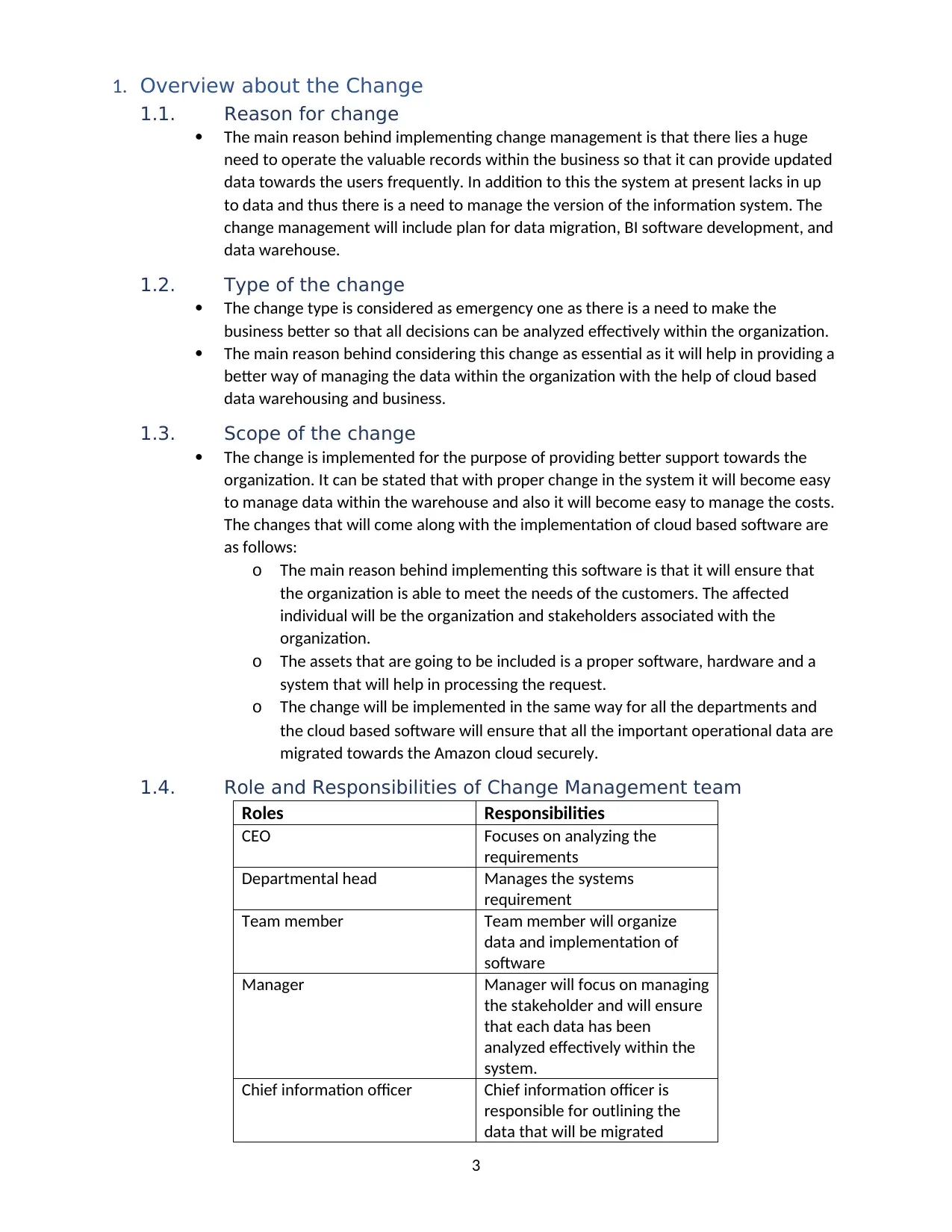
1. Overview about the Change
1.1. Reason for change
The main reason behind implementing change management is that there lies a huge
need to operate the valuable records within the business so that it can provide updated
data towards the users frequently. In addition to this the system at present lacks in up
to data and thus there is a need to manage the version of the information system. The
change management will include plan for data migration, BI software development, and
data warehouse.
1.2. Type of the change
The change type is considered as emergency one as there is a need to make the
business better so that all decisions can be analyzed effectively within the organization.
The main reason behind considering this change as essential as it will help in providing a
better way of managing the data within the organization with the help of cloud based
data warehousing and business.
1.3. Scope of the change
The change is implemented for the purpose of providing better support towards the
organization. It can be stated that with proper change in the system it will become easy
to manage data within the warehouse and also it will become easy to manage the costs.
The changes that will come along with the implementation of cloud based software are
as follows:
o The main reason behind implementing this software is that it will ensure that
the organization is able to meet the needs of the customers. The affected
individual will be the organization and stakeholders associated with the
organization.
o The assets that are going to be included is a proper software, hardware and a
system that will help in processing the request.
o The change will be implemented in the same way for all the departments and
the cloud based software will ensure that all the important operational data are
migrated towards the Amazon cloud securely.
1.4. Role and Responsibilities of Change Management team
Roles Responsibilities
CEO Focuses on analyzing the
requirements
Departmental head Manages the systems
requirement
Team member Team member will organize
data and implementation of
software
Manager Manager will focus on managing
the stakeholder and will ensure
that each data has been
analyzed effectively within the
system.
Chief information officer Chief information officer is
responsible for outlining the
data that will be migrated
3
1.1. Reason for change
The main reason behind implementing change management is that there lies a huge
need to operate the valuable records within the business so that it can provide updated
data towards the users frequently. In addition to this the system at present lacks in up
to data and thus there is a need to manage the version of the information system. The
change management will include plan for data migration, BI software development, and
data warehouse.
1.2. Type of the change
The change type is considered as emergency one as there is a need to make the
business better so that all decisions can be analyzed effectively within the organization.
The main reason behind considering this change as essential as it will help in providing a
better way of managing the data within the organization with the help of cloud based
data warehousing and business.
1.3. Scope of the change
The change is implemented for the purpose of providing better support towards the
organization. It can be stated that with proper change in the system it will become easy
to manage data within the warehouse and also it will become easy to manage the costs.
The changes that will come along with the implementation of cloud based software are
as follows:
o The main reason behind implementing this software is that it will ensure that
the organization is able to meet the needs of the customers. The affected
individual will be the organization and stakeholders associated with the
organization.
o The assets that are going to be included is a proper software, hardware and a
system that will help in processing the request.
o The change will be implemented in the same way for all the departments and
the cloud based software will ensure that all the important operational data are
migrated towards the Amazon cloud securely.
1.4. Role and Responsibilities of Change Management team
Roles Responsibilities
CEO Focuses on analyzing the
requirements
Departmental head Manages the systems
requirement
Team member Team member will organize
data and implementation of
software
Manager Manager will focus on managing
the stakeholder and will ensure
that each data has been
analyzed effectively within the
system.
Chief information officer Chief information officer is
responsible for outlining the
data that will be migrated
3
⊘ This is a preview!⊘
Do you want full access?
Subscribe today to unlock all pages.

Trusted by 1+ million students worldwide
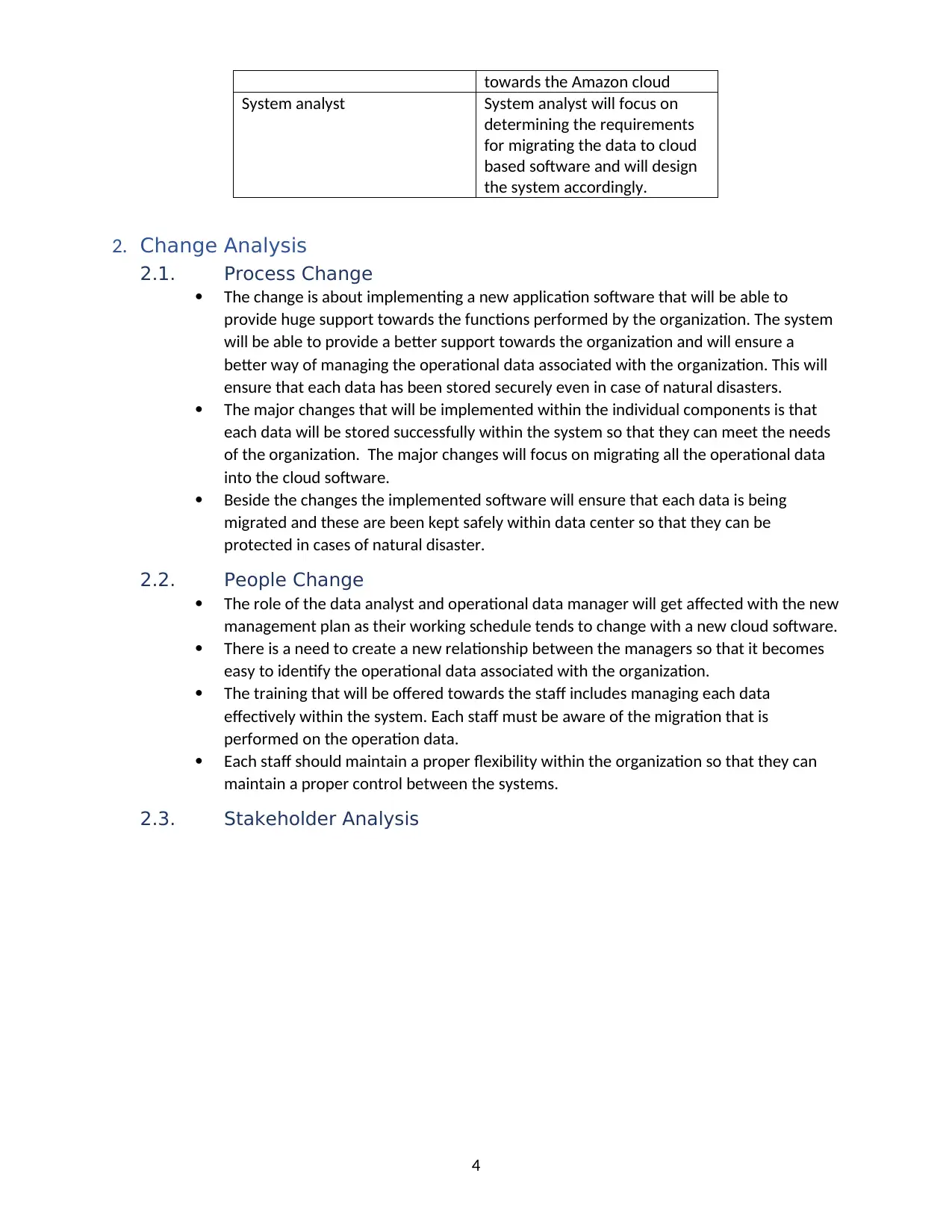
towards the Amazon cloud
System analyst System analyst will focus on
determining the requirements
for migrating the data to cloud
based software and will design
the system accordingly.
2. Change Analysis
2.1. Process Change
The change is about implementing a new application software that will be able to
provide huge support towards the functions performed by the organization. The system
will be able to provide a better support towards the organization and will ensure a
better way of managing the operational data associated with the organization. This will
ensure that each data has been stored securely even in case of natural disasters.
The major changes that will be implemented within the individual components is that
each data will be stored successfully within the system so that they can meet the needs
of the organization. The major changes will focus on migrating all the operational data
into the cloud software.
Beside the changes the implemented software will ensure that each data is being
migrated and these are been kept safely within data center so that they can be
protected in cases of natural disaster.
2.2. People Change
The role of the data analyst and operational data manager will get affected with the new
management plan as their working schedule tends to change with a new cloud software.
There is a need to create a new relationship between the managers so that it becomes
easy to identify the operational data associated with the organization.
The training that will be offered towards the staff includes managing each data
effectively within the system. Each staff must be aware of the migration that is
performed on the operation data.
Each staff should maintain a proper flexibility within the organization so that they can
maintain a proper control between the systems.
2.3. Stakeholder Analysis
4
System analyst System analyst will focus on
determining the requirements
for migrating the data to cloud
based software and will design
the system accordingly.
2. Change Analysis
2.1. Process Change
The change is about implementing a new application software that will be able to
provide huge support towards the functions performed by the organization. The system
will be able to provide a better support towards the organization and will ensure a
better way of managing the operational data associated with the organization. This will
ensure that each data has been stored securely even in case of natural disasters.
The major changes that will be implemented within the individual components is that
each data will be stored successfully within the system so that they can meet the needs
of the organization. The major changes will focus on migrating all the operational data
into the cloud software.
Beside the changes the implemented software will ensure that each data is being
migrated and these are been kept safely within data center so that they can be
protected in cases of natural disaster.
2.2. People Change
The role of the data analyst and operational data manager will get affected with the new
management plan as their working schedule tends to change with a new cloud software.
There is a need to create a new relationship between the managers so that it becomes
easy to identify the operational data associated with the organization.
The training that will be offered towards the staff includes managing each data
effectively within the system. Each staff must be aware of the migration that is
performed on the operation data.
Each staff should maintain a proper flexibility within the organization so that they can
maintain a proper control between the systems.
2.3. Stakeholder Analysis
4
Paraphrase This Document
Need a fresh take? Get an instant paraphrase of this document with our AI Paraphraser
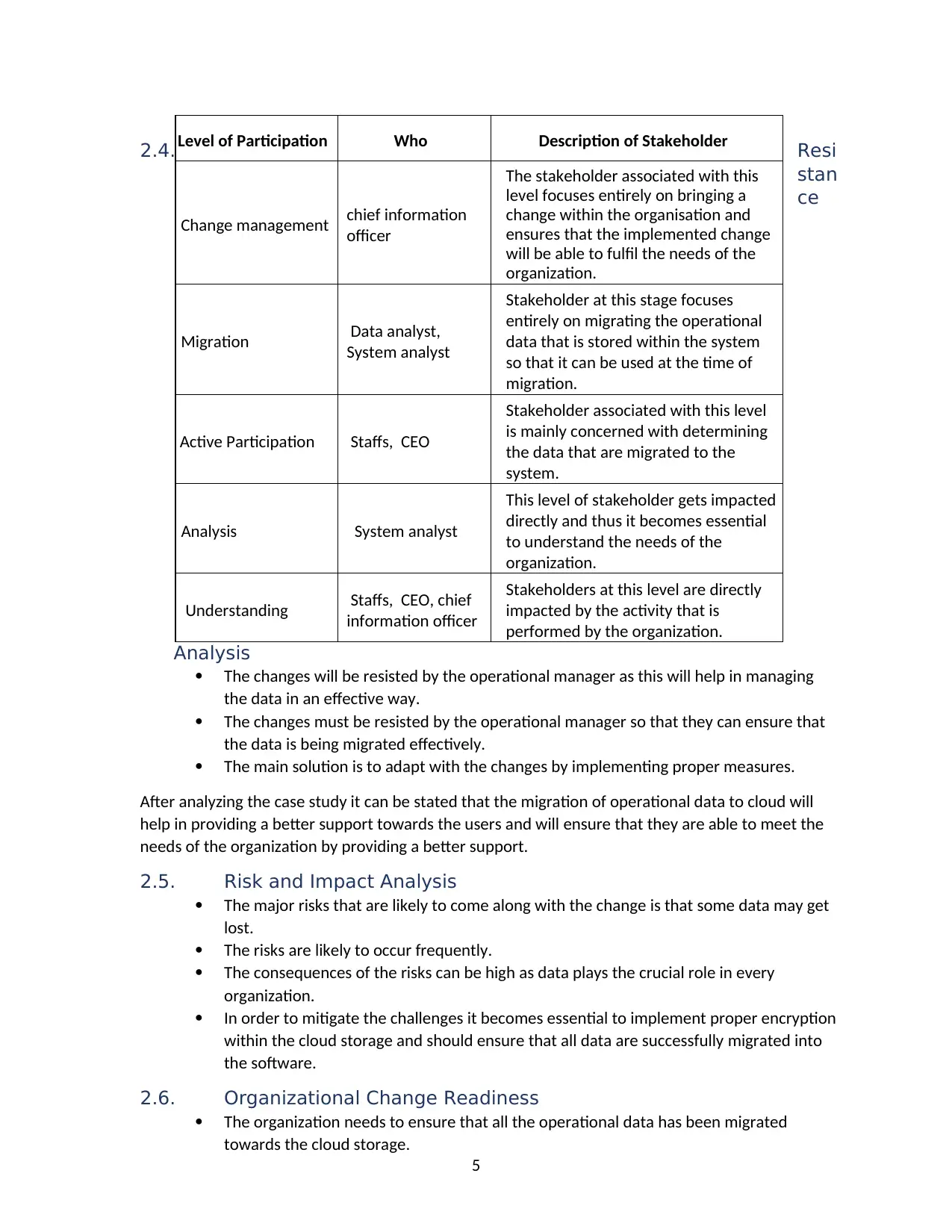
2.4. Resi
stan
ce
Analysis
The changes will be resisted by the operational manager as this will help in managing
the data in an effective way.
The changes must be resisted by the operational manager so that they can ensure that
the data is being migrated effectively.
The main solution is to adapt with the changes by implementing proper measures.
After analyzing the case study it can be stated that the migration of operational data to cloud will
help in providing a better support towards the users and will ensure that they are able to meet the
needs of the organization by providing a better support.
2.5. Risk and Impact Analysis
The major risks that are likely to come along with the change is that some data may get
lost.
The risks are likely to occur frequently.
The consequences of the risks can be high as data plays the crucial role in every
organization.
In order to mitigate the challenges it becomes essential to implement proper encryption
within the cloud storage and should ensure that all data are successfully migrated into
the software.
2.6. Organizational Change Readiness
The organization needs to ensure that all the operational data has been migrated
towards the cloud storage.
5
Level of Participation Who Description of Stakeholder
Change management chief information
officer
The stakeholder associated with this
level focuses entirely on bringing a
change within the organisation and
ensures that the implemented change
will be able to fulfil the needs of the
organization.
Migration Data analyst,
System analyst
Stakeholder at this stage focuses
entirely on migrating the operational
data that is stored within the system
so that it can be used at the time of
migration.
Active Participation Staffs, CEO
Stakeholder associated with this level
is mainly concerned with determining
the data that are migrated to the
system.
Analysis System analyst
This level of stakeholder gets impacted
directly and thus it becomes essential
to understand the needs of the
organization.
Understanding Staffs, CEO, chief
information officer
Stakeholders at this level are directly
impacted by the activity that is
performed by the organization.
stan
ce
Analysis
The changes will be resisted by the operational manager as this will help in managing
the data in an effective way.
The changes must be resisted by the operational manager so that they can ensure that
the data is being migrated effectively.
The main solution is to adapt with the changes by implementing proper measures.
After analyzing the case study it can be stated that the migration of operational data to cloud will
help in providing a better support towards the users and will ensure that they are able to meet the
needs of the organization by providing a better support.
2.5. Risk and Impact Analysis
The major risks that are likely to come along with the change is that some data may get
lost.
The risks are likely to occur frequently.
The consequences of the risks can be high as data plays the crucial role in every
organization.
In order to mitigate the challenges it becomes essential to implement proper encryption
within the cloud storage and should ensure that all data are successfully migrated into
the software.
2.6. Organizational Change Readiness
The organization needs to ensure that all the operational data has been migrated
towards the cloud storage.
5
Level of Participation Who Description of Stakeholder
Change management chief information
officer
The stakeholder associated with this
level focuses entirely on bringing a
change within the organisation and
ensures that the implemented change
will be able to fulfil the needs of the
organization.
Migration Data analyst,
System analyst
Stakeholder at this stage focuses
entirely on migrating the operational
data that is stored within the system
so that it can be used at the time of
migration.
Active Participation Staffs, CEO
Stakeholder associated with this level
is mainly concerned with determining
the data that are migrated to the
system.
Analysis System analyst
This level of stakeholder gets impacted
directly and thus it becomes essential
to understand the needs of the
organization.
Understanding Staffs, CEO, chief
information officer
Stakeholders at this level are directly
impacted by the activity that is
performed by the organization.
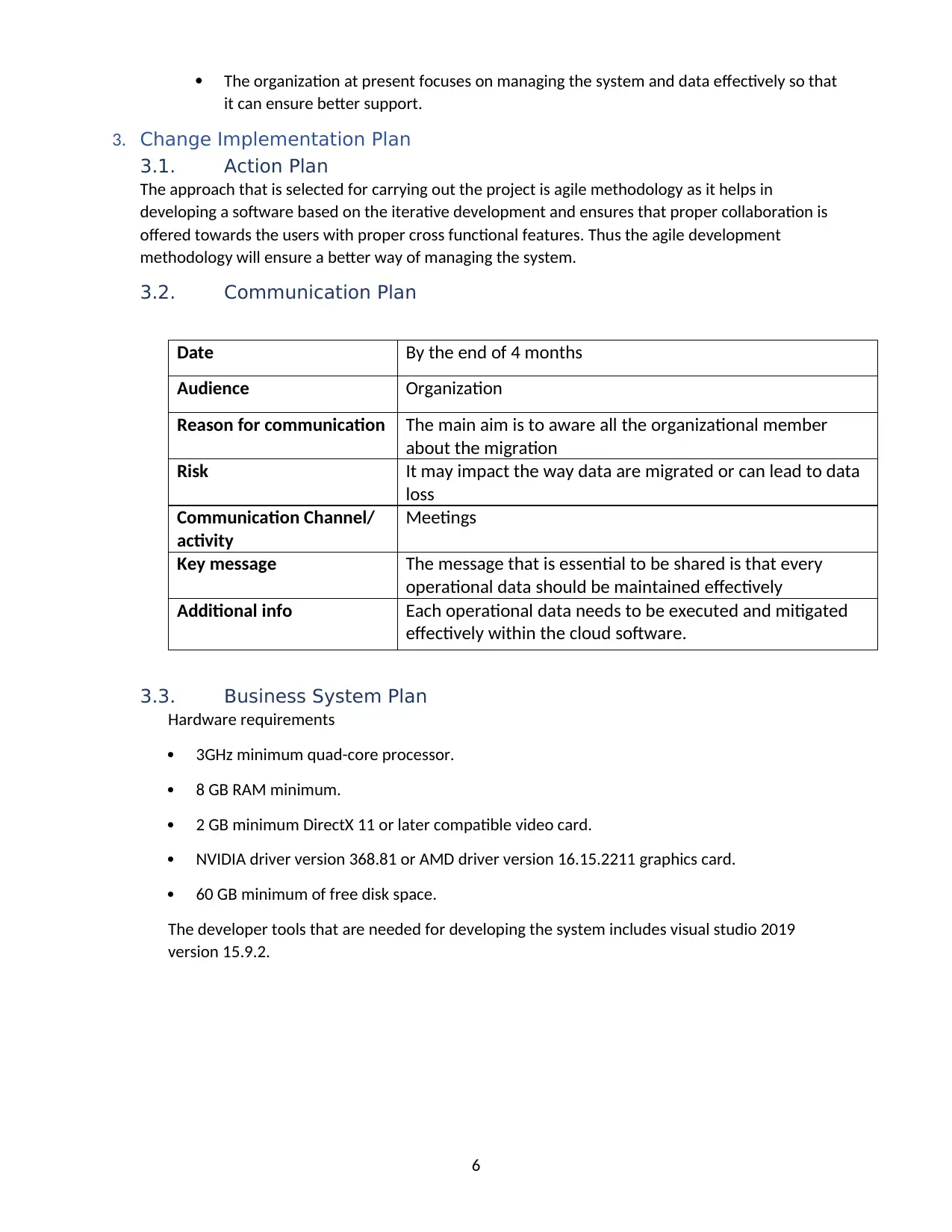
The organization at present focuses on managing the system and data effectively so that
it can ensure better support.
3. Change Implementation Plan
3.1. Action Plan
The approach that is selected for carrying out the project is agile methodology as it helps in
developing a software based on the iterative development and ensures that proper collaboration is
offered towards the users with proper cross functional features. Thus the agile development
methodology will ensure a better way of managing the system.
3.2. Communication Plan
Date By the end of 4 months
Audience Organization
Reason for communication The main aim is to aware all the organizational member
about the migration
Risk It may impact the way data are migrated or can lead to data
loss
Communication Channel/
activity
Meetings
Key message The message that is essential to be shared is that every
operational data should be maintained effectively
Additional info Each operational data needs to be executed and mitigated
effectively within the cloud software.
3.3. Business System Plan
Hardware requirements
3GHz minimum quad-core processor.
8 GB RAM minimum.
2 GB minimum DirectX 11 or later compatible video card.
NVIDIA driver version 368.81 or AMD driver version 16.15.2211 graphics card.
60 GB minimum of free disk space.
The developer tools that are needed for developing the system includes visual studio 2019
version 15.9.2.
6
it can ensure better support.
3. Change Implementation Plan
3.1. Action Plan
The approach that is selected for carrying out the project is agile methodology as it helps in
developing a software based on the iterative development and ensures that proper collaboration is
offered towards the users with proper cross functional features. Thus the agile development
methodology will ensure a better way of managing the system.
3.2. Communication Plan
Date By the end of 4 months
Audience Organization
Reason for communication The main aim is to aware all the organizational member
about the migration
Risk It may impact the way data are migrated or can lead to data
loss
Communication Channel/
activity
Meetings
Key message The message that is essential to be shared is that every
operational data should be maintained effectively
Additional info Each operational data needs to be executed and mitigated
effectively within the cloud software.
3.3. Business System Plan
Hardware requirements
3GHz minimum quad-core processor.
8 GB RAM minimum.
2 GB minimum DirectX 11 or later compatible video card.
NVIDIA driver version 368.81 or AMD driver version 16.15.2211 graphics card.
60 GB minimum of free disk space.
The developer tools that are needed for developing the system includes visual studio 2019
version 15.9.2.
6
⊘ This is a preview!⊘
Do you want full access?
Subscribe today to unlock all pages.

Trusted by 1+ million students worldwide
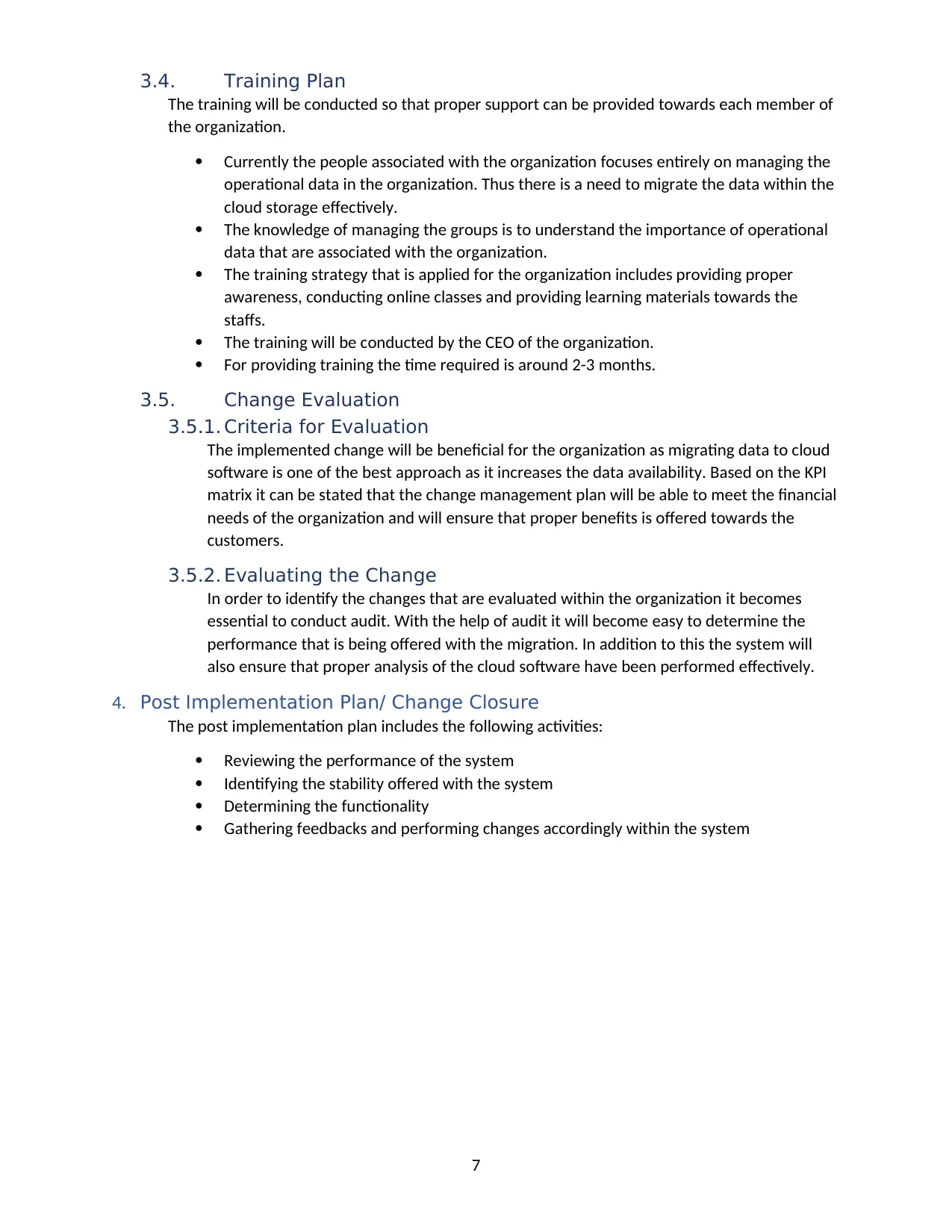
3.4. Training Plan
The training will be conducted so that proper support can be provided towards each member of
the organization.
Currently the people associated with the organization focuses entirely on managing the
operational data in the organization. Thus there is a need to migrate the data within the
cloud storage effectively.
The knowledge of managing the groups is to understand the importance of operational
data that are associated with the organization.
The training strategy that is applied for the organization includes providing proper
awareness, conducting online classes and providing learning materials towards the
staffs.
The training will be conducted by the CEO of the organization.
For providing training the time required is around 2-3 months.
3.5. Change Evaluation
3.5.1. Criteria for Evaluation
The implemented change will be beneficial for the organization as migrating data to cloud
software is one of the best approach as it increases the data availability. Based on the KPI
matrix it can be stated that the change management plan will be able to meet the financial
needs of the organization and will ensure that proper benefits is offered towards the
customers.
3.5.2. Evaluating the Change
In order to identify the changes that are evaluated within the organization it becomes
essential to conduct audit. With the help of audit it will become easy to determine the
performance that is being offered with the migration. In addition to this the system will
also ensure that proper analysis of the cloud software have been performed effectively.
4. Post Implementation Plan/ Change Closure
The post implementation plan includes the following activities:
Reviewing the performance of the system
Identifying the stability offered with the system
Determining the functionality
Gathering feedbacks and performing changes accordingly within the system
7
The training will be conducted so that proper support can be provided towards each member of
the organization.
Currently the people associated with the organization focuses entirely on managing the
operational data in the organization. Thus there is a need to migrate the data within the
cloud storage effectively.
The knowledge of managing the groups is to understand the importance of operational
data that are associated with the organization.
The training strategy that is applied for the organization includes providing proper
awareness, conducting online classes and providing learning materials towards the
staffs.
The training will be conducted by the CEO of the organization.
For providing training the time required is around 2-3 months.
3.5. Change Evaluation
3.5.1. Criteria for Evaluation
The implemented change will be beneficial for the organization as migrating data to cloud
software is one of the best approach as it increases the data availability. Based on the KPI
matrix it can be stated that the change management plan will be able to meet the financial
needs of the organization and will ensure that proper benefits is offered towards the
customers.
3.5.2. Evaluating the Change
In order to identify the changes that are evaluated within the organization it becomes
essential to conduct audit. With the help of audit it will become easy to determine the
performance that is being offered with the migration. In addition to this the system will
also ensure that proper analysis of the cloud software have been performed effectively.
4. Post Implementation Plan/ Change Closure
The post implementation plan includes the following activities:
Reviewing the performance of the system
Identifying the stability offered with the system
Determining the functionality
Gathering feedbacks and performing changes accordingly within the system
7
Paraphrase This Document
Need a fresh take? Get an instant paraphrase of this document with our AI Paraphraser
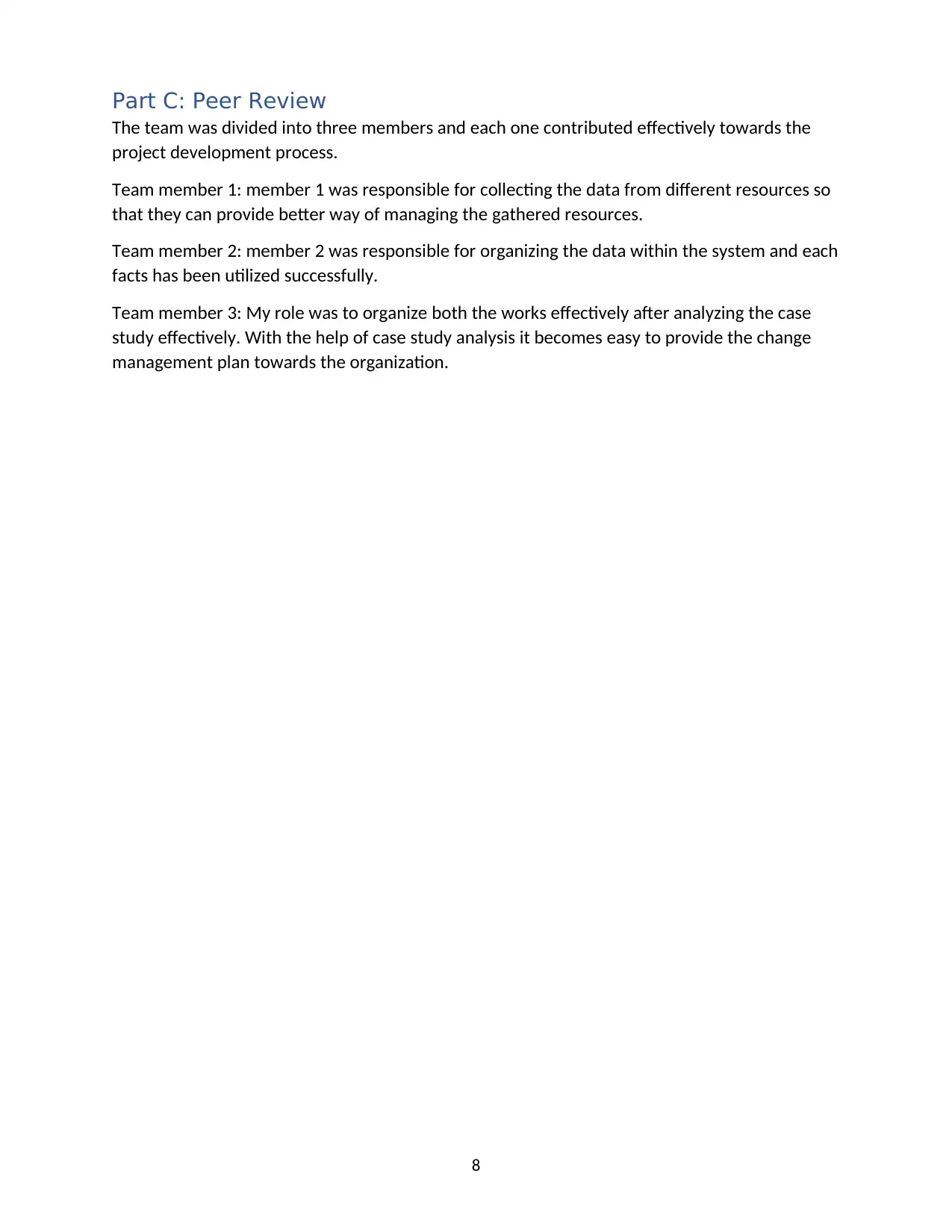
Part C: Peer Review
The team was divided into three members and each one contributed effectively towards the
project development process.
Team member 1: member 1 was responsible for collecting the data from different resources so
that they can provide better way of managing the gathered resources.
Team member 2: member 2 was responsible for organizing the data within the system and each
facts has been utilized successfully.
Team member 3: My role was to organize both the works effectively after analyzing the case
study effectively. With the help of case study analysis it becomes easy to provide the change
management plan towards the organization.
8
The team was divided into three members and each one contributed effectively towards the
project development process.
Team member 1: member 1 was responsible for collecting the data from different resources so
that they can provide better way of managing the gathered resources.
Team member 2: member 2 was responsible for organizing the data within the system and each
facts has been utilized successfully.
Team member 3: My role was to organize both the works effectively after analyzing the case
study effectively. With the help of case study analysis it becomes easy to provide the change
management plan towards the organization.
8
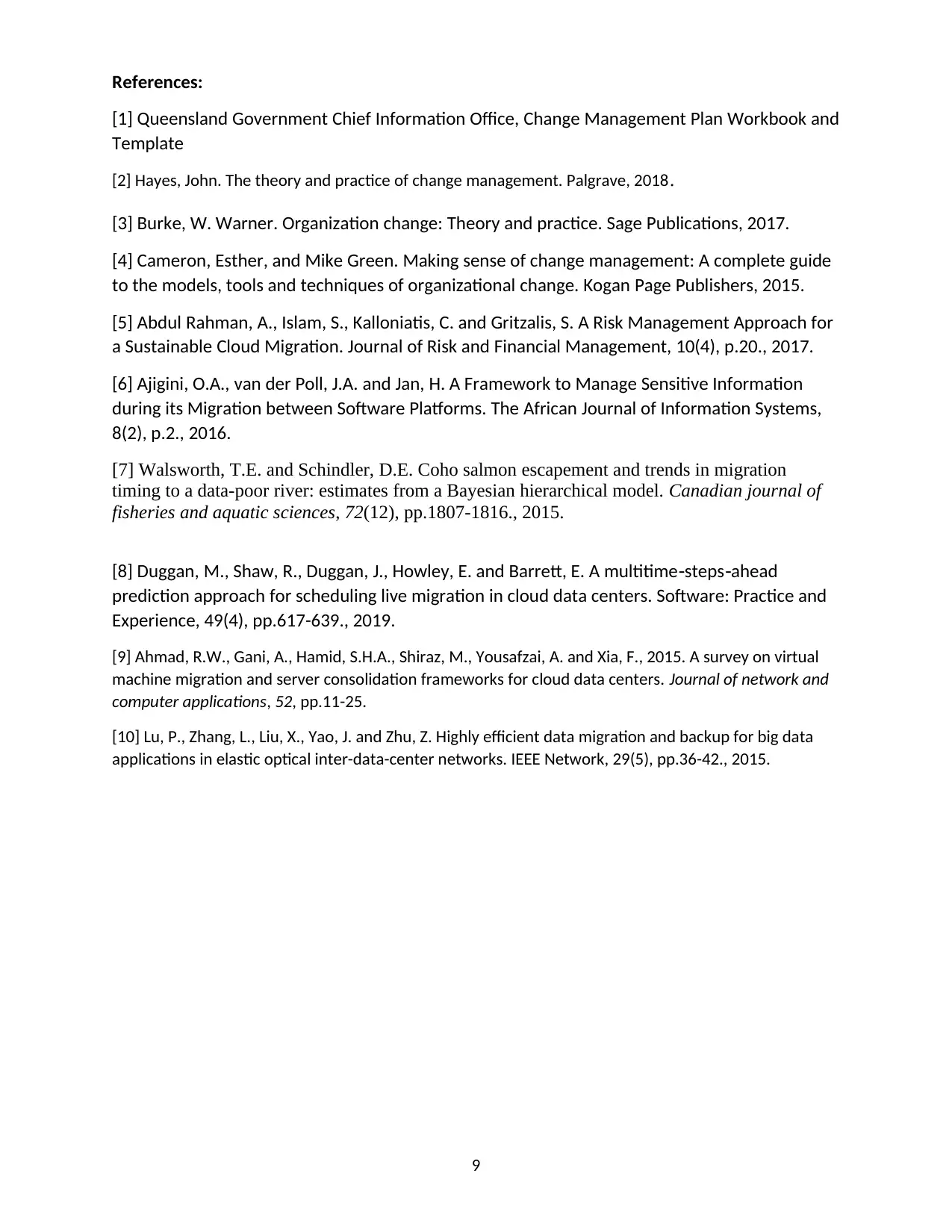
References:
[1] Queensland Government Chief Information Office, Change Management Plan Workbook and
Template
[2] Hayes, John. The theory and practice of change management. Palgrave, 2018.
[3] Burke, W. Warner. Organization change: Theory and practice. Sage Publications, 2017.
[4] Cameron, Esther, and Mike Green. Making sense of change management: A complete guide
to the models, tools and techniques of organizational change. Kogan Page Publishers, 2015.
[5] Abdul Rahman, A., Islam, S., Kalloniatis, C. and Gritzalis, S. A Risk Management Approach for
a Sustainable Cloud Migration. Journal of Risk and Financial Management, 10(4), p.20., 2017.
[6] Ajigini, O.A., van der Poll, J.A. and Jan, H. A Framework to Manage Sensitive Information
during its Migration between Software Platforms. The African Journal of Information Systems,
8(2), p.2., 2016.
[7] Walsworth, T.E. and Schindler, D.E. Coho salmon escapement and trends in migration
timing to a data-poor river: estimates from a Bayesian hierarchical model. Canadian journal of
fisheries and aquatic sciences, 72(12), pp.1807-1816., 2015.
[8] Duggan, M., Shaw, R., Duggan, J., Howley, E. and Barrett, E. A multitime steps ahead‐ ‐
prediction approach for scheduling live migration in cloud data centers. Software: Practice and
Experience, 49(4), pp.617-639., 2019.
[9] Ahmad, R.W., Gani, A., Hamid, S.H.A., Shiraz, M., Yousafzai, A. and Xia, F., 2015. A survey on virtual
machine migration and server consolidation frameworks for cloud data centers. Journal of network and
computer applications, 52, pp.11-25.
[10] Lu, P., Zhang, L., Liu, X., Yao, J. and Zhu, Z. Highly efficient data migration and backup for big data
applications in elastic optical inter-data-center networks. IEEE Network, 29(5), pp.36-42., 2015.
9
[1] Queensland Government Chief Information Office, Change Management Plan Workbook and
Template
[2] Hayes, John. The theory and practice of change management. Palgrave, 2018.
[3] Burke, W. Warner. Organization change: Theory and practice. Sage Publications, 2017.
[4] Cameron, Esther, and Mike Green. Making sense of change management: A complete guide
to the models, tools and techniques of organizational change. Kogan Page Publishers, 2015.
[5] Abdul Rahman, A., Islam, S., Kalloniatis, C. and Gritzalis, S. A Risk Management Approach for
a Sustainable Cloud Migration. Journal of Risk and Financial Management, 10(4), p.20., 2017.
[6] Ajigini, O.A., van der Poll, J.A. and Jan, H. A Framework to Manage Sensitive Information
during its Migration between Software Platforms. The African Journal of Information Systems,
8(2), p.2., 2016.
[7] Walsworth, T.E. and Schindler, D.E. Coho salmon escapement and trends in migration
timing to a data-poor river: estimates from a Bayesian hierarchical model. Canadian journal of
fisheries and aquatic sciences, 72(12), pp.1807-1816., 2015.
[8] Duggan, M., Shaw, R., Duggan, J., Howley, E. and Barrett, E. A multitime steps ahead‐ ‐
prediction approach for scheduling live migration in cloud data centers. Software: Practice and
Experience, 49(4), pp.617-639., 2019.
[9] Ahmad, R.W., Gani, A., Hamid, S.H.A., Shiraz, M., Yousafzai, A. and Xia, F., 2015. A survey on virtual
machine migration and server consolidation frameworks for cloud data centers. Journal of network and
computer applications, 52, pp.11-25.
[10] Lu, P., Zhang, L., Liu, X., Yao, J. and Zhu, Z. Highly efficient data migration and backup for big data
applications in elastic optical inter-data-center networks. IEEE Network, 29(5), pp.36-42., 2015.
9
⊘ This is a preview!⊘
Do you want full access?
Subscribe today to unlock all pages.

Trusted by 1+ million students worldwide
1 out of 9
Related Documents
Your All-in-One AI-Powered Toolkit for Academic Success.
+13062052269
info@desklib.com
Available 24*7 on WhatsApp / Email
![[object Object]](/_next/static/media/star-bottom.7253800d.svg)
Unlock your academic potential
Copyright © 2020–2025 A2Z Services. All Rights Reserved. Developed and managed by ZUCOL.





